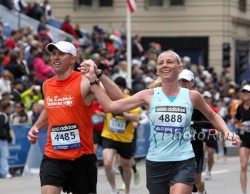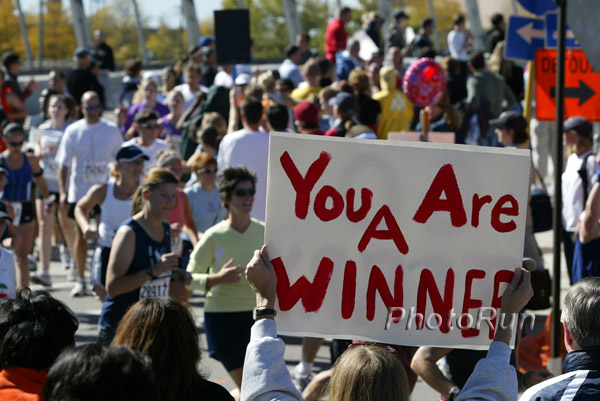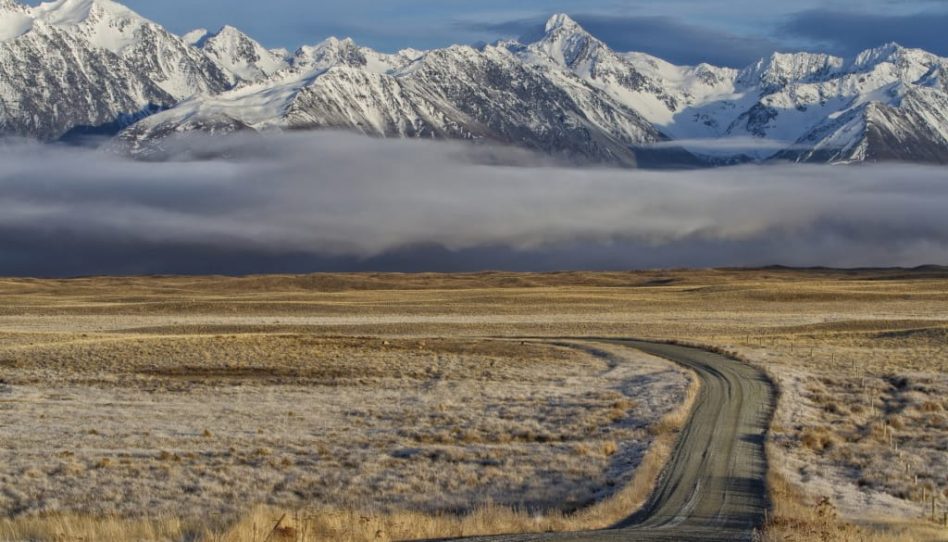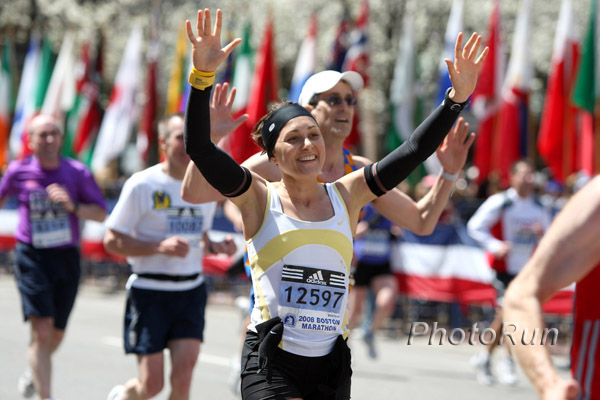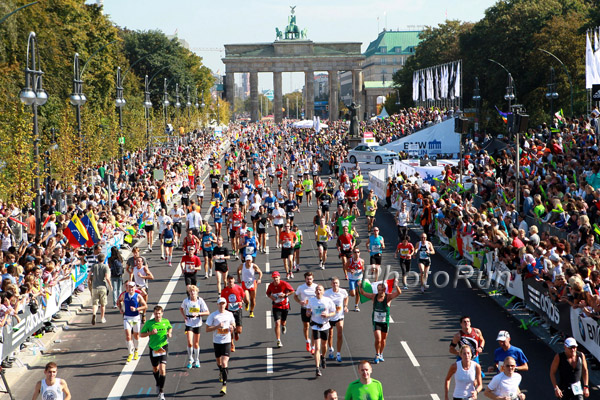The World Marathon Majors—From the Ground Up
The five races which comprise the World Marathon Majors—Boston, London, Berlin, Chicago, and New York—attract runners of every calibre. For the elite, these races offer the chance of winning world wide recognition, the knowledge that you are #1, and prize money. For other runners, there are the challenges and rewards of personal records, of meeting inner goals, or of raising money for a charity.
But no matter what the level of the runner, there is one challenge that remains the same for all: the geography of the marathon course. Take The Magic Step® contributor Andy Edwards recently spoke with Professor Sean Hartnett about the specific surfaces and geography of these five major courses. Hartnett, a professor of geography and anthropology at the University of Wisconsin-Eau Claire, is a veritable treasure trove of knowledge concerning road race courses—knowledge that can help any runner navigate a course with more insight and strategy.
Boston

The absence of man-made landmarks is one of the factors which set Boston apart from the other major marathons. Held, like London, in April, it is the oldest of the five marathons—dating back to 1897 in the wake of the first modern Olympic Games. Sean Hartnett sees the race’s start in Hopkinton as a throwback to that era. He notes that the course “parallels a train line, so it’s like station to station” as it winds its way towards the city of Boston.
This traditional route presents some potential problems. He states that “in some places the roads are very narrow, that’s why the field is limited. In some parts the road is only 40 feet wide. But the biggest problem is the terrain. Basically you’re running downhill from the suburbs to sea level.”
This descent, coupled with the fact that the course runs in one direction, prevents Boston from receiving official recognition for world records and fast times. The downhill also needs to be taken into account, according to Hartnett, when considering how to tackle the challenge of “The Newton Hills,” which start around 16 miles into the race.
“The first part of Boston, maybe the first 3 or 4 miles, you drop over 350 feet and the (elite) athletes hold back to avoid trashing their legs. From there, right up to 16 miles, it’s somewhat flat so you can get some good running done. Right after 16 you drop down to the Charles River, you’re almost at sea level at 16.5 miles and then you start to climb a series of hills.”
Now we’ve arrived at the infamous “Newton Hills,” which are a series of hills ending with the famous “Heartbreak Hill.” “It’s kind of like a staircase of hills,” said Hartnett. “And in those 5 miles, only a mile or 1.2 miles is really uphill. It’s really uphill followed by flat or gently downhill followed by uphill. To get up those hills after dropping down to sea level is really taxing. But the biggest problem most people have with Boston is the final 5 miles after those hills. You’re faced with going back downhill which seems easy but your legs are trashed by that stage. The goal in Boston is to be able to cope with that final stretch of three or four miles—and be able to enjoy the crowd.”
Uta’s Tip: Be careful not to start the race too fast because the initial downhill course will encourage you to speed up your pace. This will “pound” your legs and rob you of the freshness you will need towards the finish.
One of the keys to mentally preparing for Boston is to train for a gentle up and down landscape—the rolling hills. Then, after you have made it through the first 16.5 miles, you will have the stamina you need to conquer the notorius Newton Hills.
London

The British capital offers a race rich in historic landmarks ever since the first running in 1981. What grabs Sean Hartnett’s attention about London is a downhill stretch not long after the race has begun from Blackheath in South London.
“One of the difficulties is that most of the elevation drop occurs around the three mile mark. So many athletes (among the elite) have not taken advantage of that—the one exception was Paula Radcliffe who set a world record in 2003 and took advantage of that elevation drop because she considered it as money in the bank.”
After that early stretch, London follows a mostly flat course though it has its fair share of turns, especially in the mid-section of the race. Coping with turns rather than running perfectly straight can use up energy but nothing too unsettling for someone who is properly prepared. As for the landmarks, competitors cross Tower Bridge over the River Thames at halfway. As the runners head for the finish, Buckingham Palace looms into view. Sean Hartnett believes that taking a mental note when you pass these landmarks can help—and that applies to the elite as well.
“You’re completing a route and in your mind you can see parts of it and there’s a certain pull towards the finish area and you know you’re approaching it. The final stretch along the Embankment (beside the River Thames) is pretty much a straightaway approach and that is traditionally where the race unfolds, it’s a perfect venue for the unfolding of the race.
“In the final stretch you have a couple of turns and the turn 250-280 meters from the finish has proven quite pivotal. In recent years we’ve sometimes had four or five people come off that turn and where you’re positioned really determines how you finish in the last sprint.”
Uta’s Tip: I’ve never run London, but from talking to fellow competitors and coaches, I understand it is a fast course that offers the potential for setting personal bests. Besides necessary long runs, tempo runs and interval workouts will help you prepare for this. The unpredictable spring weather in London is something you may want to keep in mind during your running preparation and strategy.
Berlin

The Berlin Marathon grew from its beginnings in 1974 to achieve a solid reputation by the 1980s. But in 1990, after the fall of the Berlin Wall, the race entered a new era when the course was changed to run through the newly reunified city. Run at the end of September, its conditions are almost always nearly perfect. As with Chicago, it has developed a reputation as a world record-breaking race and Sean Hartnett sees two reasons for this.
“I think of it as the fastest of the five courses. The roads are flat, they don’t have a camber (a crown in the middle of the road), are mostly asphalt except for a few little spots in the city’s center. But what really sets it up is the running from 10K to 30K that is on nice, tree-lined boulevards that are kind of intimate for runners. It’s protected and you can get some good running done and that’s what sets Berlin apart. Another aspect is that it’s very well lined with spectators, especially in that boulevard area and then, when it moves out into a more open area, the city centre is packed with fans and the historic finish through the Brandenburg Gate is a good one.”
Before the finish comes into view, runners also have the benefit of the last 10K or so, which is a gradual descent, not the potentially punishing downhill of Boston, but a stretch which gives fresh impetus to many.
Uta’s Tip: Spectators during this race are extremely supportive! I agree with Sean that the course is the fastest of the five—plus you get wonderful crowd support that encourages you to have a terrific time. Run smoothly up to the well-known round about, Wilder Eber, at the 28K point. This is the key—run the miles leading up to the Wilder Eber carefully so that you have energy left to take advantage of the gradual descent to the finish.
Chicago
From its debut in 1977, Chicago grew to be one of the world’s top marathons in the1980s before its fortunes took a dip. It has been resurrected in fine style, however, now offering a faster course which has been the stage for men’s and women’s world records in recent years. Held in early October, Sean Hartnett acknowledges it to be one of the flattest courses where the only elevation variation is over bridges and at the finish. As with Berlin, the start and finish are conveniently close together. Hartnett points out some key course changes in recent years.
“The route has been changed to try and improve it; four or five years ago they changed the final stretch so there’s a straightaway on asphalt now, moving it away from cement to make it faster.”
Chicago’s nickname is “The Windy City” so can that also apply on race day? Hartnett gives a qualified answer and an insight into changing views on how weather conditions affect a race.
“It can be. One of the things we find is that wind can be one of the more subtle deterrents against fast times. We used to think temperature was but now we have a somewhat elastic view of temperature—actually when Khannouchi set the world record (1999) it was 32 degrees (Fahrenheit) at the start, it was freezing and we thought it would be too cold but he set the world record. But the winds were very light.”
Hartnett adds a warning that the wind can be a factor in the closing stages.
“One of the problems with Chicago’s new finish is that the final three or four kilometers are into the wind. In the first year of the new course, Evans Rutto was on course for a world record when he turned into the wind. It stood him up and the record went out the window.”
Uta’s Tip: I have been on the course several times, running sections to support some of our friends and elite athletes, but I have never run the marathon course competitively. I agree with Sean that the wind can be a major factor in your finish. So check out the course—and especially the wind direction on marathon day. This will dictate your strategy for the final miles of the race. If the wind will be coming at you in the last miles, you need to take this into account in your pre-race strategy evaluation.
New York
After six years held entirely within Central Park, the New York marathon branched out to run through the city’s five boroughs in 1976, creating an especially vivid experience for any newcomer to New York. The first two miles or so are certainly different than most marathons as runners cross from Staten Island via the Verrazano Narrows Bridge to enter Brooklyn with Central Park as their ultimate destination. Sean Hartnett considers the course to be on a par with Boston as the most demanding of the World Marathon Majors.
“New York is very challenging. It not only has significant downhills right at the start and then you have a couple of bridges as well but also at 16 miles you come onto First Avenue and that’s almost at sea level, so you have to climb from sea level up to Central Park so that’s an uphill late in the race, particularly the 23rd mile is a climb of 85 feet, so that makes it a Waterloo for many people.”
Road surface is another factor where New York is a race apart, says Harnett.
“The roads are really well crowned for drainage so you can fatigue one or the other of your legs when one is a little bit lower when the foot strikes. I used to say that New York is the world’s longest cross-country race because you have the hills and you run on every conceivable surface, whether it’s crossing bridges, or running on asphalt over brick, or cement over cobblestones (you can actually feel the cobblestones). They used to have a stretch of grass but they got rid of that; you’re constantly adapting to different types of surfaces.”
For the elite and those a little further down the field, distribution of effort can pose a problem.
“It’s hard to plan your tactics because you’re thinking, ‘How am I going to gauge my effort?’. But your effort always has to be gauged by the terrain and the conditions. Besides the bridges and the rise at 23 miles, the last mile and a half is in Central Park where there’s barely anything flat, you’re rolling up and down hills and even before the finish there’s an uphill and then a little downhill.”
Uta’s Tip: When you come onto First Avenue at about 16 miles, the downhill invites you to speed up. Be smart and run this section smoothly to save some energy to be able to climb towards Central Park. When you enter Central Park, take a deep breath, stay mentally strong, and try to run as smoothly as you can through the rolling hills at the end of this historic marathon.
Uta’s 5 Major Marathon Conclusion:
Overall, each of the five marathons has a unique structure and is well organized and a lot of fun. You can run fast times—and maybe even lower your personal best—in Chicago, London, and Berlin. In New York and Boston, however, you will face more challenging terrains that will literally give you a breath-taking experience!
- Posted April 3, 2009
© Copyright 2009-2024 by Take The Magic Step®. All Rights Reserved.


